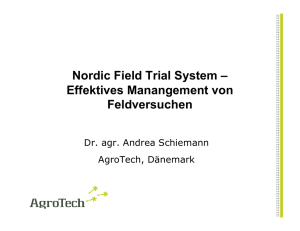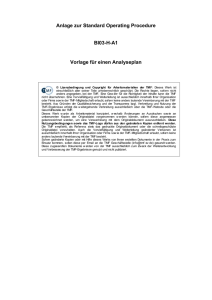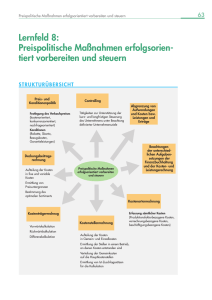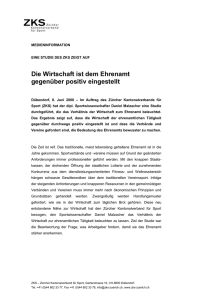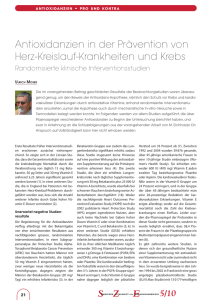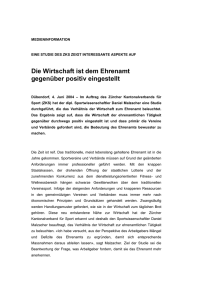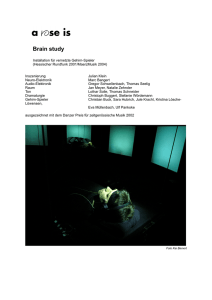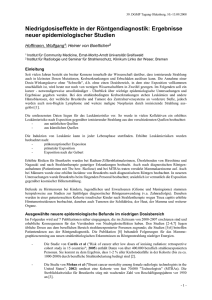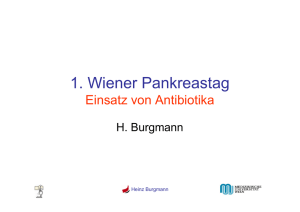Antrag auf Finanzierung einer Klinischen Studie (Sachbeihilfe)
Werbung
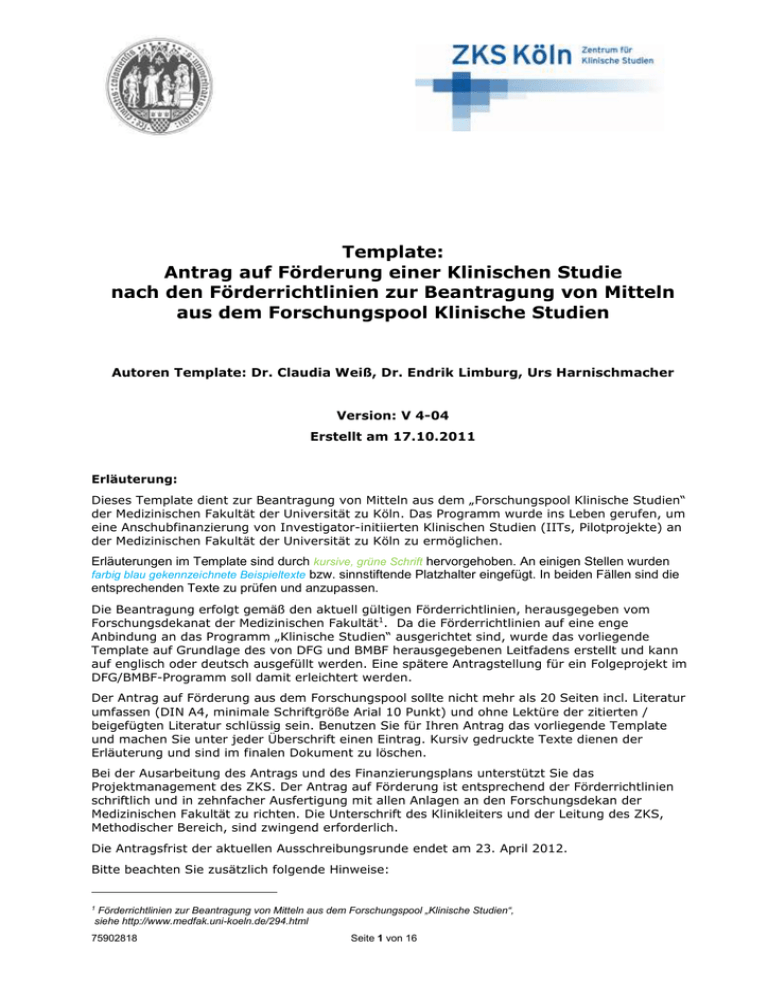
Template: Antrag auf Förderung einer Klinischen Studie nach den Förderrichtlinien zur Beantragung von Mitteln aus dem Forschungspool Klinische Studien Autoren Template: Dr. Claudia Weiß, Dr. Endrik Limburg, Urs Harnischmacher Version: V 4-04 Erstellt am 17.10.2011 Erläuterung: Dieses Template dient zur Beantragung von Mitteln aus dem „Forschungspool Klinische Studien“ der Medizinischen Fakultät der Universität zu Köln. Das Programm wurde ins Leben gerufen, um eine Anschubfinanzierung von Investigator-initiierten Klinischen Studien (IITs, Pilotprojekte) an der Medizinischen Fakultät der Universität zu Köln zu ermöglichen. Erläuterungen im Template sind durch kursive, grüne Schrift hervorgehoben. An einigen Stellen wurden farbig blau gekennzeichnete Beispieltexte bzw. sinnstiftende Platzhalter eingefügt. In beiden Fällen sind die entsprechenden Texte zu prüfen und anzupassen. Die Beantragung erfolgt gemäß den aktuell gültigen Förderrichtlinien, herausgegeben vom Forschungsdekanat der Medizinischen Fakultät1. Da die Förderrichtlinien auf eine enge Anbindung an das Programm „Klinische Studien“ ausgerichtet sind, wurde das vorliegende Template auf Grundlage des von DFG und BMBF herausgegebenen Leitfadens erstellt und kann auf englisch oder deutsch ausgefüllt werden. Eine spätere Antragstellung für ein Folgeprojekt im DFG/BMBF-Programm soll damit erleichtert werden. Der Antrag auf Förderung aus dem Forschungspool sollte nicht mehr als 20 Seiten incl. Literatur umfassen (DIN A4, minimale Schriftgröße Arial 10 Punkt) und ohne Lektüre der zitierten / beigefügten Literatur schlüssig sein. Benutzen Sie für Ihren Antrag das vorliegende Template und machen Sie unter jeder Überschrift einen Eintrag. Kursiv gedruckte Texte dienen der Erläuterung und sind im finalen Dokument zu löschen. Bei der Ausarbeitung des Antrags und des Finanzierungsplans unterstützt Sie das Projektmanagement des ZKS. Der Antrag auf Förderung ist entsprechend der Förderrichtlinien schriftlich und in zehnfacher Ausfertigung mit allen Anlagen an den Forschungsdekan der Medizinischen Fakultät zu richten. Die Unterschrift des Klinikleiters und der Leitung des ZKS, Methodischer Bereich, sind zwingend erforderlich. Die Antragsfrist der aktuellen Ausschreibungsrunde endet am 23. April 2012. Bitte beachten Sie zusätzlich folgende Hinweise: Förderrichtlinien zur Beantragung von Mitteln aus dem Forschungspool „Klinische Studien“, siehe http://www.medfak.uni-koeln.de/294.html 1 75902818 Seite 1 von 16 1. Eine Beratung durch das ZKS Köln und das Institut für Medizinische Statistik, Informatik und Epidemiologie (IMSIE) zu Beginn der Antragstellung und spätestens bis 30.01.2012 ist obligatorisch. Termine können jeweils montags und donnerstags vom 09.01.2012 bis zum 30.01.2012 zwischen 14 und 17 Uhr (je 1 Std) nach Anmeldung unter 478-88121 (Sekretariat ZKS Köln, Frau Hoerner) vereinbart werden. Die Beratung findet in der Bibliothek des IMSIE statt. 2. Ist im Verlauf der Antragserarbeitung absehbar, dass die Studie den Vorgaben der Medizinischen Fakultät entsprechend der Förderrichtlinie (siehe http://www.medfak.unikoeln.de/294.html) nicht entspricht, so sollte frühzeitig erwogen werden, ob eine weitere Bearbeitung sinnvoll ist und ggf. auf anderem Wege eine Finanzierung eingeworben werden kann. Hier sind insbesondere folgende Punkte zu nennen: a) Gesamtkosten der Studie überschreiten den vorgegebenen zulässigen Höchstrahmen. b) Laufzeit von Vorbereitung/ Ethikantrag bis Abschluss/Bericht (ohne Publikation) > 2 Jahre. c) GCP-Konformität nicht gewährleistet (u.a. qualitätssichernde Maßnahmen wie z.B. Monitoring). Bei Planung einer sogenannten Anwendungsbeobachtung muss ein Statement durch die Ethik- Kommission eingeholt werden (dass diese der Einschätzung als AWB folgen kann). 3. Wenn industrielle Interessen an der Fragestellung des Projektes (Arzneimittel-Studie, Studie nach Medizinprodukte-Gesetz) nicht zu erwarten sind und eine industrielle Unterstützung nicht möglich ist, muss dies ausführlich begründet dargestellt werden (Paragraph 1 Abs. (2)). Sollte eine Co-Finanzierung durch die Industrie möglich sein, ist diese ausdrücklich erwünscht. 4. Generell dient die Beantragung von Mitteln im Forschungspool „Klinische Studien“ der Unterstützung fokussierter Pilotprojekte im Sinne von Vorarbeiten und nicht bereits in sich abgeschlossener Studien. Darüber hinaus ist insbesondere darzulegen, wie im Falle einer Bewilligung ein konkretes perspektivisches Anschlussprojekt aussehen soll und welche Finanzierung (Drittmittel) dafür angestrebt wird. 5. Der Antrag sollte auf der Grundlage der zur Verfügung gestellten Vorlage (Template) erstellt werden. Diese wird auf der o.g. Internetseite zum Download bereitgestellt. Bitte beachten Sie: Die Anträge werden seitens des Dekanats auch auf formale Kriterien geprüft und werden, falls sie den Vorgaben nicht entsprechen, ggf. nicht zur Begutachtung angenommen. 75902818 Seite 2 von 16 Antrag auf Förderung von Projekten aus dem Forschungspool „Klinische Studien“ Institution: Antragsteller/ -in: Telefon: Funk: Fax: E-Mail: Projekttitel: Zusammenfassung des Projekts (kurz): Laufzeit der Studie: 1 Jahr Die Gesamtkosten der Studie in Höhe von: Beginn: Juli 2010 90.000,- € teilen sich wie folgt auf: Leistung Klinik: Summe 30.000,- € Leistung ZKS incl. IMSIE: Summe 50.000,- € Sachkosten: Summe 10.000,- € Beantragte Mittel der Fakultät: Summe 30.000,- € teilen sich auf in: Klinik: ZKS: 20.000,- € Sachkosten: 10.000,- € -,- € Eigenleistung Klinik: 30.000 € Eigenleistung ZKS: 30.000 € 75902818 Seite 3 von 16 Abschluss: Juli 2011 Erklärung für alle Neu- und Verlängerungsanträge Ich erkläre hiermit gegenüber der Medizinischen Fakultät der Universität zu Köln, dass das o.a. Projekt nicht aus anderen Fördermitteln unterstützt wird und dass ich bei keiner anderen Förderungsinstitution einen vergleichbaren Antrag auf Förderung gestellt habe. Anträge auf komplementäre Förderung bereits bestehender geförderter Projekte habe ich entsprechend kenntlich gemacht. Ich erkläre mich damit einverstanden, dass der Titel meiner Arbeit namentlich im Rahmen des Programms „Klinische Studien“ veröffentlicht werden kann. Die Beantragung einer Starthilfe im Programm „Klinische Studien“ wird durch das ZKS unterstützt. Köln, den (Unterschrift Antragsteller) (Unterschrift Instituts-/ Klinik-Direktor/-in) (Unterschrift Leitung ZKS, Methodischer Bereich) 75902818 Seite 4 von 16 Inhalt: 1 2 3 Study Synopsis ____________________________________________________________________________ 6 1.1 Key Words _________________________________________________________________ 6 1.2 Intervention Scheme / Trial Flow _______________________________________________ 6 1.3 Frequency and Scope of study Visits ____________________________________________ 6 1.4 Stopping Rules _______________________________________ Error! Bookmark not defined. 1.5 Additional Treatments ________________________________ Error! Bookmark not defined. The Medical Problem ______________________________________________________________________ 6 2.1 Evidence___________________________________________________________________ 6 2.2 The need for a trial __________________________________________________________ 7 2.3 Strategies for the dissemination of Results _______________________________________ 7 Justification of Design Aspects _______________________________________________________________ 7 3.1 Control(s)/comparator(s) _____________________________________________________ 7 3.2 Dose, Mode, and Scheme of intervention ________________________________________ 7 3.3 Inclusion/exclusion criteria ____________________________________________________ 7 3.4 Outcome measures __________________________________________________________ 7 3.5 Methods against bias ________________________________________________________ 8 3.6 Proposed sample size/power calculations ________________________________________ 8 3.7 Feasibility of Recruitment _____________________________________________________ 8 4 Statistical Analyses ________________________________________________________________________ 9 5 Ethical Considerations ______________________________________________________________________ 9 6 Quality Assurance and Safety________________________________________________________________ 9 6.1 Quality assurance / monitoring ________________________________________________ 9 6.2 Safety _____________________________________________________________________ 9 7 Trial Timeline Flow ________________________________________________________________________ 9 8 List of Participants involved in the Trial ______________________________________________________ 11 9 References ________________________________________________________ Error! Bookmark not defined. 10 Financial Details of the Trial ________________________________________________________________ 12 11 10.1 Commercial Interest ________________________________________________________ 12 10.2 Financial Plan ______________________________________________________________ 12 Appendices ______________________________________________________________________________ 16 75902818 Seite 5 von 16 1 TITLE OF STUDY CONDITION OBJECTIVE(S) INTERVENTION (S) KEY INCLUSION AND EXCLUSION CRITERIA OUTCOME(S) STUDY TYPE STATISTICAL ANALYSIS SAMPLE SIZE STUDY SYNOPSIS The medical condition being studied (e.g. asthma, myocardial infarction, depression) Which principal research questions are to be addressed? Specify clearly the primary hypotheses of the trial that determines sample size calculation. Description of the experimental and the control treatments or interventions as well as dose and mode of application. For diagnostic tests or procedures the index test and the reference procedure (goldstandard) should be described. Experimental intervention: Control intervention: Duration of intervention per patient: Experimental and/or control off label or on label in Germany: if applicable Follow-up per patient: Key inclusion criteria: Key exclusion criteria: Primary efficacy endpoint: Key secondary endpoint(s): Assessment of safety: e.g. randomized/non-randomized, type of masking (single, double, observer blind), type of controls (active/placebo), parallel group/crossover, prognostic, diagnostic Efficacy: Description of the primary efficacy analysis and population: Safety: Secondary endpoints: To be assessed for eligibility (n = …) To be allocated to trial (n = …) TRIAL DURATION To be analysed (n = …) First patient in to last patient out: Duration of the entire trial: 1.1 KEY WORDS 1.2 INTERVENTION SCHEME / TRIAL FLOW Describe the intervention scheme and give a schematic diagram (flow chart) of design, procedures and stages. 1.3 FREQUENCY AND SCOPE OF STUDY VISITS What is the proposed frequency and scope of study visits and, if applicable, the duration of post-trial follow-up? Please also give a schematic diagram. 2 THE MEDICAL PROBLEM Which medical problem is to be addressed? What is the novel aspect of the proposed trial? Which principal research questions are to be addressed? Bring them into order indicating major and minor motivations/starting hypotheses of the investigation planned. 2.1 EVIDENCE Set your trial into perspective. This section should detail the background of the starting hypotheses and the feasibility of the trial. Which trials have been conducted either by you or by others? What is the relevance of their results? Give references to any relevant systematic review(s) and/or (own) pilot studies, feasibility studies, relevant previous/ongoing trials, case reports/ series. State what your study adds to the totality of evidence when your study is 75902818 Seite 6 von 16 added to previous work. Include a description of how you searched for the evidence (databases, search terms, limits) and how you assessed its quality — i.e., how you selected and how you combined the evidence. Note that missing evidence precludes funding. 2.2 THE NEED FOR A TRIAL How significant is the trial in terms of its potential impact of relieving the burden of disease and/or improving human health? What impact will the results have on clinical practice? How will the individual patient and benefit from the trial? Describe any potential commercial interest of a company in the results of the trial or explain why no such interest exists. Note that direct commercial interest of a company in the results of the trial precludes funding. Begründung der besonderen Förderwürdigkeit Übertragbarkeit und Nachhaltigkeit des des Projekts, Angaben zur Modellhaftigkeit, Innovation, Vorhabens1:§3 (3) 5. Geben Sie hier auch einen Überblick über die eigenen Vorarbeiten zum Thema, die die Notwendigkeit der Förderung des beantragten Projektes unterstreichen1:§3 (3) 4. 2.3 STRATEGIES FOR DATA HANDLING AND THE DISSEMINATION OF RESULTS Describe what measures will be implemented to ensure the data management, curation and long-term preservation for future reuse. Please regard existing standards and data repositories where appropriate. What will be your strategies for the dissemination of results? Indicate how the expected results of the trial will be used; discuss dissemination of results, especially beyond regular journal publication, describe intended measures. Perspektivische Entwicklungsmöglichkeiten, geplante externe Anschlußfinanzierung1:§3 (3) 5. 3 JUSTIFICATION OF DESIGN ASPECTS Please do provide justifications and do not only list the respective parameters. 3.1 CONTROL(S)/COMPARATOR(S) Justify the choice of control(s)/comparison(s): Is placebo acceptable? Is there a gold standard? Which trials establish efficacy and safety of the chosen control regimen? 3.2 DOSE, MODE, AND SCHEME OF INTERVENTION Justify the dose, the mode and the scheme of the intervention. How does the intervention compare to other interventions for the same condition? 3.3 ADDITIONAL TREATMENTS Please describe the medication(s)/treatment(s) permitted (including rescue medication) and not permitted before and/or during the trial, if applicable. 3.4 INCLUSION/EXCLUSION CRITERIA Justify the population to be studied, include reflections on generalisability and representativeness. 3.5 OUTCOME MEASURES Justify the endpoints chosen: Are there other trials that have utilized this endpoint. Are there any guidelines proposing this endpoint/these endpoints? Discuss the clinical relevance of the outcome measures for the target population. Have the measures been validated? Justify appropriateness and limitations of composite endpoints, if applicable. 75902818 Seite 7 von 16 3.5.1 Determination of primary and secondary measures How will primary and secondary endpoints be derived from actual measurements, e.g. how is the figure used in the statistical test calculated from the variables initially measured in the subjects? 3.6 METHODS AGAINST BIAS Is randomisation feasible? Which prognostic factors need to be regarded in the randomization scheme and the analysis? What are the proposed practical arrangements for allocating participants to trial groups? Will trial site effects be considered in randomisation? Is blinding possible? If blinding is not possible please explain why and give details of alternative methods to avoid biased assessment of results (e.g. blinded assessment of outcome). 3.7 PROPOSED SAMPLE SIZE/POWER CALCULATIONS What is the proposed sample size and what is the justification for the assumptions underlying the power calculations? Include a comprehensible, checkable description of the power calculations and sample sizes detailing the outcome measures on which these have been based for both control and experimental groups; give event rates, means and medians, etc., as appropriate. Justify the size of difference that the trial is powered to detect, or in case of a noninferiority or equivalence study, the size of difference that the trial is powered to exclude. Give evidence for the estimated effect size. It is important that the sample size calculations take into account anticipated rates of noncompliance and losses to follow up. 3.7.1 Compliance/Rate of loss to follow up Provide details for assumptions on compliance issues. On what evidence are the compliance figures based? What is the assumed rate of loss to follow up? On what evidence is the loss to follow up rate based? How will losses to follow up or non-compliance be handled in the statistical analysis? 3.8 FEASIBILITY OF RECRUITMENT What is the evidence that the intended recruitment rate is achievable (e.g. pilot study)? a) Pilot study Has any pilot study been carried out using this design? b) Achievability of recruitment rate What is the evidence that the intended recruitment rate is achievable? Demonstrate conclusively the potential for recruiting the required number of suitable subjects (the best piece of evidence being pilot studies and preceding trials in a similar population/same institutions). How did you assess that you can recruit the necessary number of patients in each participating centre? Show justification of numbers of eligible patients per trial site in a table. The recruitment plan should show the projected recruitment including the criteria for the selection of trial sites. 3.9 STOPPING RULES Please specify the “stopping rules” or “discontinuation criteria” a) for the individual patient and b) for the whole trial. Please specify rules for closing participating centers, which fail to include the estimated number of patients. 75902818 Seite 8 von 16 4 STATISTICAL ANALYSES What is the proposed strategy of statistical analysis? If multiple hypotheses are foreseen for confirmatory testing what is the procedure to ensure Type I error control and what will be the primary data analysis set (e.g. ITT-population in case of a superiority RCT). What is the strategy for analysing the primary outcome? If interim analyses are planned, please specify. Are there any subgroup analyses? How will missing data and subjects withdrawn from the trial be handled statistically? 5 ETHICAL CONSIDERATIONS Give a description of ethical considerations relating to the trial (assessment of risks and benefits, care and protection for research participants, protection of research participants’ confidentiality, informed consent process). 6 6.1 QUALITY ASSURANCE AND SAFETY QUALITY ASSURANCE / MONITORING What are the proposed measures for quality assurance? Which institution will perform the monitoring? Which SOPs will be utilized? Describe and justify the monitoring strategy (percentage of source data verification, number of monitor visits per trial site). 6.2 SAFETY Please comment on the planned supervision of the trial (DSMB); give name and affiliation of independent DSMB members. Arrangements for the management of the trials will vary according to the nature of the study proposed. However, all should include an element of expert advice and monitoring, that is entirely independent of the principal/coordinating investigator and the medical institution involved. This will normally take the form of a scientific advisory board/trial steering committee (TSC) and/or an independent data monitoring and safety committee (DSMB). It is recognised that these arrangements may not always be appropriate and the committees needed may vary according to the nature of the study. Thus, the arrangements for supervision should be detailed and justified. The role of these committees can comprise to monitor and supervise the progress of the trial (including the safety data and the critical efficacy endpoints at intervals), to review relevant information from other sources, to ensure adherence to protocol, to consider interim analyses, to advise whether to continue, modify or stop a trial and provide the funding organisations with information and advice. Applicants should submit their proposed arrangements for overseeing of the trial and a suggested membership for the committee(s). A minimum of 3 members should be named. List under 9. 7 8 REFERENCES TRIAL TIMELINE FLOW Give a realistic overview of the planned timelines: 75902818 Seite 9 von 16 Preparation of study documents completed (study protocol etc.): 01.07.2010 Approval of Ethics Committee and Competent Authority: 01.07.2010 First patient in (FPFV): 01.07.2010 Last patient in (LPFV): 01.10.2010 Last patient out (LPLV): 01.01.2011 Database closure: 01.03.2011 Termination of statistical analysis: 01.05.2011 Termination of study report: 01.07.2011 Results published: 01.02.2012 75902818 Seite 10 von 16 9 LIST OF PARTICIPANTS INVOLVED IN THE TRIAL Trial Sponsor Trial Management # Name Affiliation Responsibility/Role Signature Principal Clinical Investigator (LKP) Investigator / responsible project leader, project management Investigator Trial statistician # Name Affiliation Signature Trial Supporting facilities # Name Affiliation Responsibility/Role ZKS Köln Monitoring, data management, SAEmanagement, advice (and support) of clinical project management / project leader Recruiting centre # Name Affiliation Data Monitoring and Safety Board (DMSB) # Name Affiliation Other participating groups / bodies (e.g. steering committee in international trials) # Name Affiliation Responsibility/Role Steering committee (if necessary) Blind review board (if necessary) Advisory Committee (if necessary) Review of trial protocol (who will review and finalize the protocol? Please refer to numbers above and/or include others) # Name 75902818 Affiliation Seite 11 von 16 10 FINANCIAL DETAILS OF THE TRIAL 10.1 COMMERCIAL INTEREST Please justify, why this trial should be funded by a public funding agency and describe any potential commercial interest of a company. Entsprechend der Vorgaben der Förderrichtlinien ist im Antrag transparent darzustellen, dass und warum davon auszugehen ist, dass keinerlei industrielle Interessen vorhanden sind und daher auch keine industrielle Finanzierung des Projektes möglich ist (Paragraph 1 Abs. (2)). Darüber hinaus ist insbesondere darzulegen, wie ein konkretes Anschlussprojekt aussehen soll und welche Finanzierung (Drittmittel) dafür angestrebt wird. 10.2 FINANCIAL PLAN 75902818 Seite 12 von 16 Organizational Segment Institution/ No of items/ Participant/ Kind of equipment/ Trial Site Explanation Qualification of staff Tätigkeitsbeschreibung, knapp Scientist / Clinical project management Klinik Project management ZKS Tätigkeitsbeschreibung, knapp Scientist Data Management ZKS Tätigkeitsbeschreibung, knapp Data manager IMSIE Tätigkeitsbeschreibung, knapp Biometrician ZKS On Site Monitoring Tätigkeitsbeschreibung, knapp Clinical Research Associate Biometry Monitoring Physician Monitoring-Tage: Anzahl Visiten * x Tage (Auswahl, Initiierung, Abschluss) + Anzahl Visiten * x Tage (Reguläre Visiten) Tage Vor- und Nachbereitung von Visiten incl. Reisezeit (Monozentrisch Köln): Anzahl Visiten * x Tage (alle Monitoring-Visiten) Generelle Monitoring-Vorbereitung Tätigkeitsbeschreibung, knapp (z.B. Einarbeitung in Studienunterlagen, Manual, Arbeitsanweisungen, Überwachung, Eskalation etc.) SAE Management Trial committees Total (€) ZKS Tätigkeitsbeschreibung, knapp Monitoring Scientist Komitee (ggf. für jedes Komitee einzeln aufführen, Notwendigkeit begründen) Tätigkeitsbeschreibung, knapp Anzahl Mitglieder je Komitee: x Mitglieder * x Stunden * x € Honorar (max. 85,- € pro Stunde) = x € Meetings/ Travel 75902818 Trial Committees gesamt: Komitee A + Komitee B + … = x € Trial Committees Komitee-Treffen ( Notwendigkeit begründen) Anzahl Komitees und Mitglieder (gesamt, alle Komitees) Anzahl Treffen (gesamt, alle Komitees) Reisespesen (durchschnittliche Reisespesen pro Treffen pro Mitglied,(nach Bundesreisekostengesetz): x € Fahrt + x € Hotel = x € Sonstige Kosten (Catering, Mieten etc.) Meetings / Travel Seite 13 von 16 Komitee-Treffen: (x Treffen * x Teilnehmer * x € Spesen) + x € Sonstiges = x € Meetings/Travel gesamt: Komitee-Treffen + Sonstige Treffen = x € Case payment Untersuchungen, diagnostische Maßnahmen, Labordiagnostik, Anzahl und Umfang kurz begründen (nur studienbedingter Mehraufwand!) Anzahl Patienten Personal (pro Patient) Qualifikation (TV-Ä) Tätigkeitsbeschreibung, knapp Personal TV-Ä: Stunden * Stundensatz1) = x € Qualifikation (TV-L) Tätigkeitsbeschreibung, knapp Personal TV-L: Stunden * Stundensatz1) = x € Sachmittel (pro Patient) (zentral zu Verfügung gestellte Sachmittel unter Materials angeben) Diagnostische Maßnahmen + Versandkosten + Labormaterial + Lagerkosten = x € ggf. Patientenhonorare, Reisekosten Case Payment gesamt: x Patienten * (Personal + Sachmittel) = x € Reference centers Case Payment Begründung der Notwendigkeit, knapp (Untersuchungen, diagnostische Maßnahmen, Labordiagnostik s. S. x Studienprotokoll oder Anzahl und Umfang kurz begründen) Anzahl Patienten Diagnostik: x Patienten * x € Maßnahme = x € Versand: x Patienten * x Proben * x € Versandkosten = x € Lager: x Patienten * x € Lagerkosten = x € Reference Centres: x € Diagnostik + x € Versand + x € Lager = x € oder Reference Centres: s. Angebot / Kostenabschätzung Materials Reference Centres Druck/Versand Unterlagen Art und Anzahl der Unterlagen (kurz begründen, Reserve berücksichtigen) Druck/Versand Unterlagen: x € Druckkosten + x € Versandkosten = x € Labormaterial Art und Anzahl der Materialien (kurz begründen, Reserve berücksichtigen) Labormaterial: (x Patienten + y Reserve) * x € Labormaterial = x € Sonstiges Material Art und Anzahl der Materialien (kurz begründen, Reserve berücksichtigen) Sonstiges Material: (x Patienten + y Reserve) * x € Material = x € 75902818 Seite 14 von 16 Materials Trial drug Materials: Druck/Versand Unterlagen + Labormaterial + Sonst. Mat. = x € Art der Ausgaben (Herstellung/Kauf, Verblindung, Etikettierung, Lagerung, Versand, Vernichtung etc.; Reserve berücksichtigen) Trial Drug: s. Angebot / Kostenabschätzung (Herstellung + Bulk Ware) oder Manufacturing: Monate * Monatssatz1) = x € Bulk Ware = x € Trial Drug = Manufacturing + Bulk Ware Trial Drug Patientenversicherung Anzahl Patienten Fees x Patienten * x € = x € oder Patientenversicherung: s. Angebot Gebühren (Genehmigungen, Amendments, Annual Safety Reports, …) Gebühren Bundesoberbehörde (begründen) Gebühren weitere zentrale Behörden ( BOpS, BfS, …) Gebühren lokale Behörden Ethikkommissionsgebühren (begründen: falls universitär, sind Gebühren Grundausstattung) Sonstige Gebühren (Begründung der Notwendigkeit, knapp) Gebühren: x € Fees: Patientenversicherung + Gebühren = x € Publications Art und Zeitpunkt der Publikationen Equipment Art und Kosten der studienspezifischen Geräte (andere Geräte Grundausstattung) Begründung der Notwendigkeit, knapp Softwarelizenzen Publications Equipment Art und Kosten der studienspezifischen Softwarelizenzen Begründung der Notwendigkeit, knapp Other Fees Art der Ausgaben Lizenzen Other Zwischensumme Klinik € Zwischensumme ZKS € Sachkosten € € TOTAL 1) Grundlage sind die aktuell gültigen Tarifverträge; anzugeben ist jeweils das Arbeitgeberbrutto 75902818 Seite 15 von 16 11 APPENDICES I. Angaben zum Antragsteller1:§3 (3)3. 1. Lebenslauf 2. Qualifikationsnachweis (incl. Nachweis über den Besuch eines Prüfarztkurses) 3. Publikationsverzeichnis II. Begründung des Finanzierungsbedarfs und Darlegung der Gesamtfinanzierung im Rahmen eines Finanzierungsplans: Einsatz des Fakultätsmittel („Forschungspool“) sowie Nachweis der Leistungsbeteiligung in gleicher Höhe durch ZKS und Klinik1:§3 (3) 8. 1. Schriftliche Zusage der zuständigen Direktorin/ des zuständigen Direktors der Forschungseinheit, dass der Antragssteller/ die Antragsstellerin im beantragten Rahmen von der klinischen bzw. diagnostischen Routinetätigkeit freigestellt wird 1:§5 (1) 2. Schriftliche Zusage über die Angebote der Kooperationspartner oder Vorlage der Angebote 3. Schriftliche Zusage des ZKS über die Bereitstellung geldwerter Leistungen (Angebot des ZKS) III. ggf. Kurzgutachten eines Projekt- unabhängigen Experten1:§3 (3) 9. IV. Erklärung des Antragsstellers, 1:§3 (3) 11. 1. dass er sich verpflichtet, sich um eine erfolgreiche Antragstellung bei externen Mittelgebern (e.g. DFG, BMBF, EU) in der Weise zu bemühen, dass diese Mittelgeber nicht veranlasst werden, ihre Zuwendungen entsprechend der Förderung zu kürzen, 2. dass das Projekt nicht bereits mit anderen Fördermitteln/ Industriemitteln unterstützt wird und/ oder dass bei keiner anderen Förderungsinstitution ein vergleichbarer Antrag auf Förderung gestellt wurde, 3. dass der Antragsteller diese Förderrichtlinien anerkennt und die darin enthaltenen Pflichten im Falle der Bewilligung beachtet. V. Schriftliche Zusage des jeweiligen verantwortlichen Klinik- und /oder Institutsleiters bzw. ggf. eines Kooperationspartners, soweit durch die Studie dessen Räumlichkeiten, Einrichtungen oder Leistungen in Anspruch genommen werden. 1:§3 (3) 12. 75902818 Seite 16 von 16
